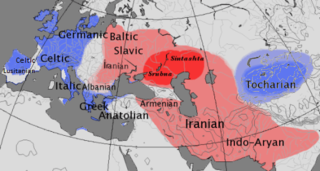Related Research Articles

In linguistics, the comparative method is a technique for studying the development of languages by performing a feature-by-feature comparison of two or more languages with common descent from a shared ancestor and then extrapolating backwards to infer the properties of that ancestor. The comparative method may be contrasted with the method of internal reconstruction in which the internal development of a single language is inferred by the analysis of features within that language. Ordinarily, both methods are used together to reconstruct prehistoric phases of languages; to fill in gaps in the historical record of a language; to discover the development of phonological, morphological and other linguistic systems and to confirm or to refute hypothesised relationships between languages.

August Schleicher was a German linguist. Schleicher studied the Proto-Indo-European language and devised theories concerning historical linguistics. His great work was A Compendium of the Comparative Grammar of the Indo-European Languages in which he attempted to reconstruct the Proto-Indo-European language. To show how Indo-European might have looked, he created a short tale, Schleicher's fable, to exemplify the reconstructed vocabulary and aspects of Indo-European society inferred from it.

Proto-Indo-European (PIE) is the reconstructed common ancestor of the Indo-European language family. No direct record of Proto-Indo-European exists; its proposed features have been derived by linguistic reconstruction from documented Indo-European languages.

Indo-European studies is a field of linguistics and an interdisciplinary field of study dealing with Indo-European languages, both current and extinct. The goal of those engaged in these studies is to amass information about the hypothetical proto-language from which all of these languages are descended, a language dubbed Proto-Indo-European (PIE), and its speakers, the Proto-Indo-Europeans, including their society and Proto-Indo-European mythology. The studies cover where the language originated and how it spread. This article also lists Indo-European scholars, centres, journals and book series.
Ernest Gottlieb Sihler (1853–1942) was a professor of classics at New York University. Born in Fort Wayne, Indiana, he was the son of Lutheran missionary Wilhelm Sihler and great-uncle to Andrew Sihler. Sihler's professional name was Ernest G. Sihler, but within the Sihler family he was always known as Gottlieb.
Numeral or number prefixes are prefixes derived from numerals or occasionally other numbers. In English and many other languages, they are used to coin numerous series of words. For example:

The Proto-Greek language is the Indo-European language which was the last common ancestor of all varieties of Greek, including Mycenaean Greek, the subsequent ancient Greek dialects and, ultimately, Koine, Byzantine and Modern Greek. Proto-Greek speakers entered Greece sometime between 2200 and 1900 BC, with the diversification into a southern and a northern group beginning by approximately 1700 BC.

Karl Brugmann was a German linguist. He is noted for his work in Indo-European linguistics.

Jacob WackernagelGerman:[ˈvakərˌnaːɡəl] was a Swiss linguist, Indo-Europeanist and scholar of Sanskrit. He was born in Basel, son of the philologist Wilhelm Wackernagel (1806–1869).
Proto-Indo-European pronouns have been reconstructed by modern linguists, based on similarities found across all Indo-European languages. This article lists and discusses the hypothesised forms.
The numerals and derived numbers of the Proto-Indo-European language (PIE) have been reconstructed by modern linguists based on similarities found across all Indo-European languages. The following article lists and discusses their hypothesized forms.
Sievers's law in Indo-European linguistics accounts for the pronunciation of a consonant cluster with a glide before a vowel as it was affected by the phonetics of the preceding syllable. Specifically it refers to the alternation between *iy and *y, and possibly *uw and *w as conditioned by the weight of the preceding syllable. For instance, Proto-Indo-European (PIE) *kor-yo-s became Proto-Germanic *harjaz, Gothic harjis "army", but PIE *ḱerdh-yo-s became Proto-Germanic *hirdijaz, Gothic hairdeis "shepherd". It differs from ablaut in that the alternation has no morphological relevance but is phonologically context-sensitive: PIE *iy followed a heavy syllable, but *y would follow a light syllable.
Ranko Matasović is a Croatian linguist, Indo-Europeanist, and Celticist.
Sihler is a surname deriving originally from Germany. Highest numbers of Sihler’s are in the United States.
James Peter Timothy Clackson is a British linguist and Indo-Europeanist. He is a professor of Comparative Philology at the Faculty of Classics, University of Cambridge, and a Fellow and Director of Studies at Jesus College, Cambridge.
Osthoff's law is an Indo-European sound law which states that long vowels shorten when followed by a resonant, followed in turn by another consonant. It is named after German Indo-Europeanist Hermann Osthoff, who first formulated it.

Languages of the Indo-European family are classified as either centum languages or satem languages according to how the dorsal consonants of the reconstructed Proto-Indo-European language (PIE) developed. An example of the different developments is provided by the words for "hundred" found in the early attested Indo-European languages. In centum languages, they typically began with a sound, but in satem languages, they often began with.
Cowgill's law, named after Indo-Europeanist Warren Cowgill, refers to two unrelated sound changes, one occurring in Proto-Greek and the other in Proto-Germanic.

The Proto-Italic language is the ancestor of the Italic languages, most notably Latin and its descendants, the Romance languages. It is not directly attested in writing, but has been reconstructed to some degree through the comparative method. Proto-Italic descended from the earlier Proto-Indo-European language.

Calvert Watkins was an American linguist and philologist, known for his book How to Kill a Dragon. He was a professor of linguistics and the classics at Harvard University and after retirement went to serve as professor-in-residence at UCLA.
References
- ↑ Olsen, Birgit Anette (2004). Indo-European word formation: proceedings of the conference held at the University of Copenhagen, October 20th - 22nd 2000. Museum Tusculanum Press. pp. 193–. ISBN 978-87-7289-821-6 . Retrieved 1 June 2011.
- ↑ "Andrew Sihler". morebooks.de. 2011-10-08. Retrieved 2022-01-30.
- ↑ A. Sihler (2006). "Edgerton's Law: The Phantom Evidence". Universitätsverlag Winter. Retrieved 2024-02-01.
- ↑ "William W. Sihler". Darden School of Business. Retrieved 2022-01-30.
- ↑ Gordon, Laura. "Sihler, Ernest Gottlieb". Database of Classical Scholars – Rutgers, The State University of New Jersey. Retrieved 2022-01-30.
- ↑ Bente, F. American Lutheranism, Volume I St. Louis: Concordia Publishing House. 1919, 116, Retrieved 2022-01-30.